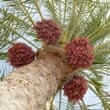Background
- The date palm (Phoenix dactylifera) has a long history of cultivation and its fruit has been used as a source of nutrition. Although its exact native distribution is unknown, it probably originated somewhere in the desert oases of northern Africa and perhaps also southwest Asia.
- Today, date palm (Phoenix dactylifera L.) fruits are part of the daily diet in many Middle Eastern and neighboring countries. Extracts of the date palm kernel have been evaluated in scientific studies for use as a topical antiwrinkle agent. Date palm is not listed on the U.S. Food and Drug Administration's (FDA) Generally Recognized as Safe (GRAS) list.
References
Natural Standard developed the above evidence-based information based on a thorough systematic review of the available scientific articles. For comprehensive information about alternative and complementary therapies on the professional level, go to . Selected references are listed below.
- Adams CD, Timms FJ, Hanlon M. Phoenix date palm injuries: a review of injuries from the Phoenix date palm treated at the Starship Children's Hospital. Aust.N.Z.J.Surg. 2000;70(5):355-357.
View Abstract - Al Farsi M, Alasalvar C, Morris A, et al. Compositional and sensory characteristics of three native sun-dried date (Phoenix dactylifera L.) varieties grown in Oman. J Agric Food Chem 9-21-2005;53(19):7586-7591.
View Abstract - Al Shahib W, Marshall RJ. The fruit of the date palm: its possible use as the best food for the future? Int.J.Food Sci.Nutr. 2003;54(4):247-259.
View Abstract - Almehdi AM, Maraqa M, Abdulkhalik S. Aerobiological studies and low allerginicity of date-palm pollen in the UAE. Int J Environ.Health Res 2005;15(3):217-224.
View Abstract - Asturias JA, Ibarrola I, Fernandez J, et al. Pho d 2, a major allergen from date palm pollen, is a profilin: cloning, sequencing, and immunoglobulin E cross-reactivity with other profilins. Clin Exp Allergy 2005;35(3):374-381.
View Abstract - Bauza E, Dal Farra C, Berghi A, et al. Date palm kernel extract exhibits antiaging properties and significantly reduces skin wrinkles. Int.J.Tissue React. 2002;24(4):131-136.
View Abstract - Bener A, Safa W, Abdulhalik S, et al. An analysis of skin prick test reactions in asthmatics in a hot climate and desert environment. Allerg.Immunol (Paris) 2002;34(8):281-286.
View Abstract - Copley MS, Rose PJ, Clapham A, et al. Detection of palm fruit lipids in archaeological pottery from Qasr Ibrim, Egyptian Nubia. Proc Biol Sci 3-22-2001;268(1467):593-597.
View Abstract - Kwaasi AA. Date palm and sandstorm-borne allergens. Clin.Exp.Allergy 2003;33(4):419-426.
View Abstract - Kwaasi AA, Harfi HA, Parhar RS, et al. Cultivar-specific IgE-epitopes in date (Phoenix dactylifera L.) fruit allergy. Correlation of skin test reactivity and ige-binding properties in selecting date cultivars for allergen standardization. Int.Arch.Allergy Immunol. 2000;123(2):137-144.
View Abstract - Kwaasi AA, Harfi HA, Parhar RS, et al. Cross-reactivities between date palm (Phoenix dactylifera L.) polypeptides and foods implicated in the oral allergy syndrome. Allergy 2002;57(6):508-518.
View Abstract - Luby SP, Rahman M, Hossain MJ, et al. Foodborne transmission of Nipah virus, Bangladesh. Emerg.Infect.Dis 2006;12(12):1888-1894.
View Abstract - Moore JE, Xu J, Millar BC, et al. Edible dates (Phoenix dactylifera), a potential source of Cladosporium cladosporioides and Sporobolomyces roseus: implications for public health. Mycopathologia 2002;154(1):25-28.
View Abstract - Taskiran E, Toros T. Chronic synovitis caused by a date palm thorn: An unusual clinical picture. Arthroscopy 2002;18(2):E7.
View Abstract - Waibel KH. Allergic rhinitis in the Middle East. Mil.Med 2005;170(12):1026-1028.
View Abstract







